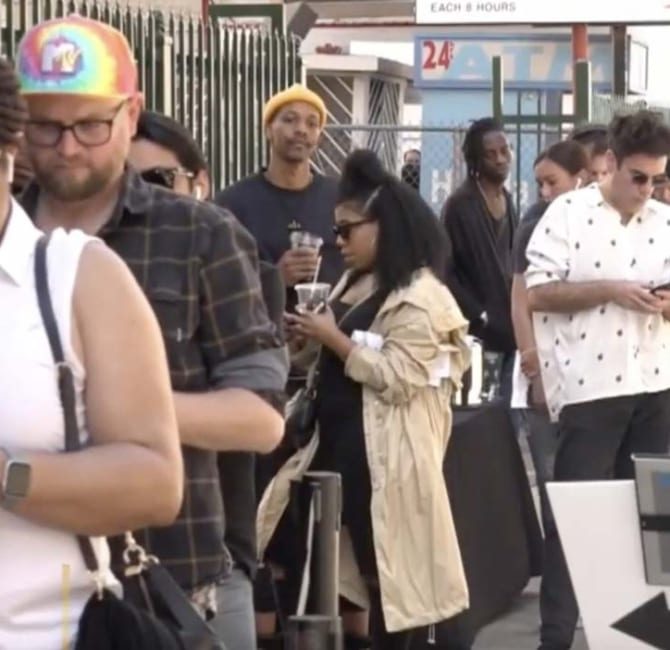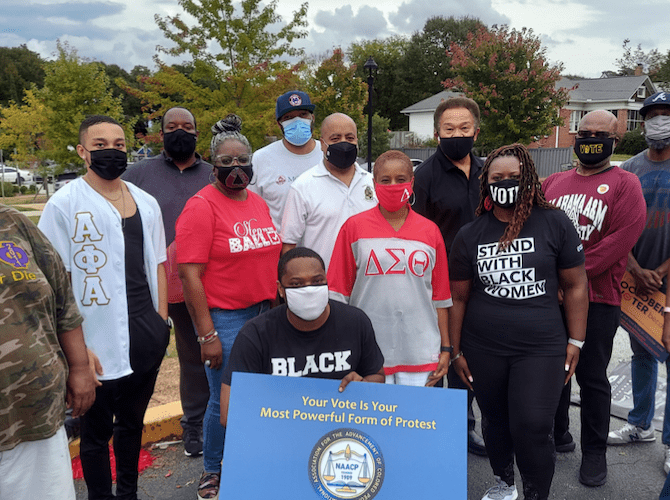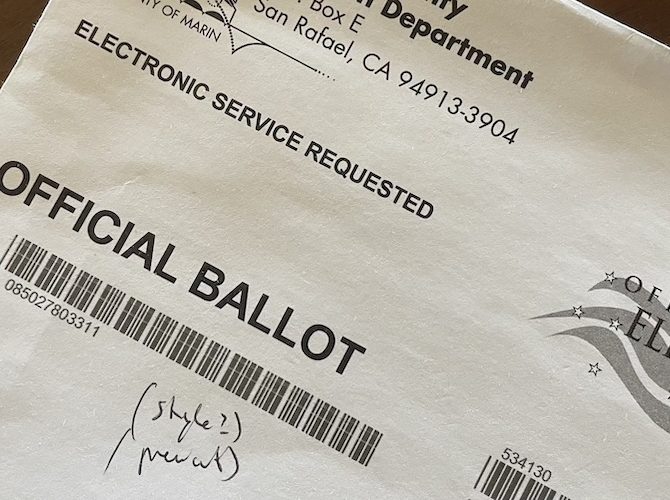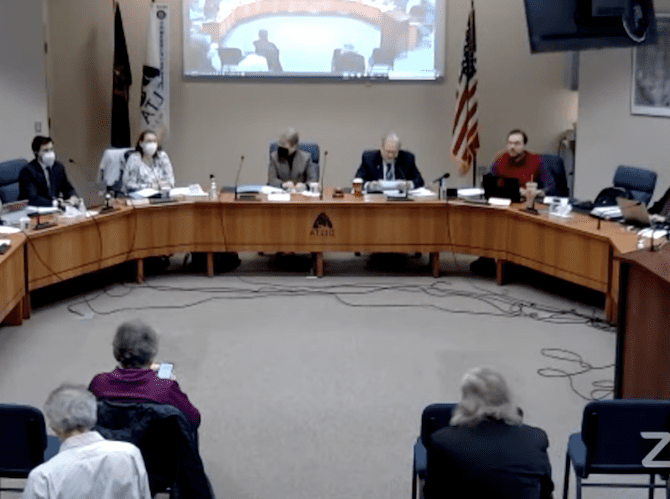Could Ballot Images Loosen the Grip of Disinformation?
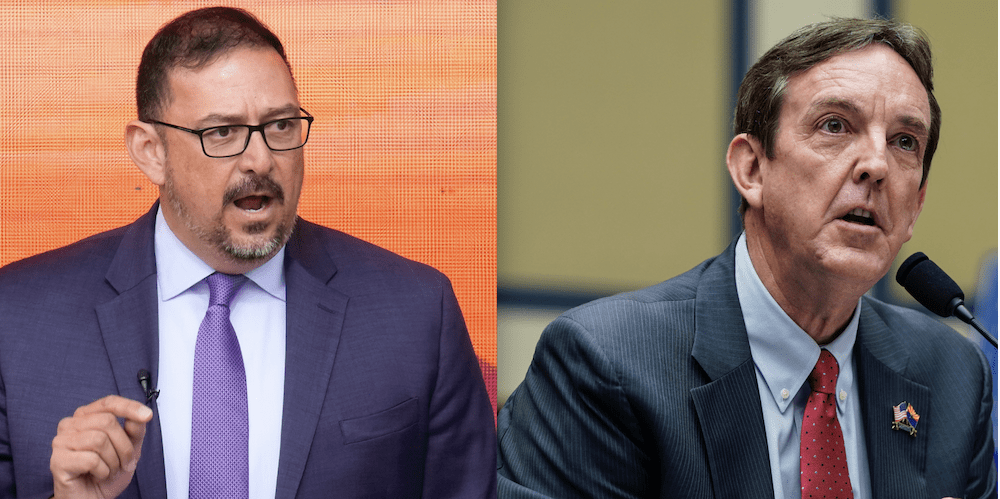
(Adrian Fontes, Arizona’s Democratic secretary of state, and his Republican predecessor, Ken Bennett. Photo credit: The Washington Monthly)
(This report was published by WashingtonMonthly.com on April 4, 2023.)
Former President Donald Trump’s indictment in New York City has put election disinformation back under the klieg lights. But across the country in Arizona, a noteworthy and nominally bipartisan reform intended to loosen disinformation’s grip has been moving ahead in one of the nation’s most Trump-friendly legislatures.
The transparency-based measure is an interesting but controversial remedy to address two commonly hurled clichés about unpopular election results. First, the bill creates a mechanism for determining whether voters who received a ballot were legal and registered. And second, it would verify if each of the choices on the ballot has been accurately counted.
S.B. 1324 does this by requiring Arizona’s counties to release four essential records used by elections officials soon after Election Day so that anyone can verify the electorate’s legality and the result’s accuracy. Any error or interference, if found, could be quickly evaluated and addressed before the window for a legal recount or election challenge litigation closed.
While different states release or sell some of these data sets, most election officials keep these administrative details out of public view. Instead, election managers typically urge voters to trust their oversight. The Arizona legislation could mark a start of changing this status quo.
“If you and I and many are tired of the continual questions about whether the election was done right or not, then… then we have to do something different than what exists right now,” Ken Bennett, a conservative Republican state senator and former Arizona secretary of state, said on the chamber floor. “You have the current secretary of state and myself strongly believing that this is a step forward. Might not be perfect, but rarely do we do anything down here that’s perfect.”
The legislation is strongly supported by Arizona’s secretary of state, Adrian Fontes, a progressive Democrat who, in 2020, oversaw the nation’s most scrutinized presidential election as the top election official in Maricopa County, home to Phoenix and a majority of Arizona voters. The county was the epicenter of the months-long “audit” in 2021 that fueled pro-Trump conspiracies and disinformation even though it concluded that Joe Biden had won.
“This is a method for public disclosure and public verifiability of elections that I have been an advocate of since 2017,” Fontes told me. “The problem this solves is a much bigger problem [than today’s disinformation]. And that is that we don’t have publicly verifiable elections.”
The first cliché the measure seeks to address is claims of mass illegal voting. Trump and Arizona’s failed 2022 GOP gubernatorial nominee, Kari Lake, continue to make that assertion. Recent polling by The Center for Election Innovation & Research, a Washington-based nonprofit, found that Republicans in Arizona—and nationally—cite illegal voting as their top fear in next year’s presidential election.
The bill seeks to address those fears by requiring counties to release two data sets that could affirm whether there was any illegal voting. The first is a list of all legal voters after registration closes (29 days in Arizona). The second is a post-Election Day list of everyone who voted. Protected voters—police, judges, and crime victims—would stay concealed. Comparing the before and after lists would reveal the extent of illegal voting.
Initially, the bill’s critics, which included Arizona county officials and state chapters of national center-left voting rights groups, said that making voter rolls more easily accessible—they now can be purchased by anyone—would violate privacy rights. Bennett addressed that concern by limiting the voter information to be released and combining precincts with 10 or fewer voters.
But opponents went on to say they do not trust Republicans, even if the bill’s lead sponsor is a former GOP secretary of state disliked by Arizona’s Trumpers.
“Bad actors could easily abuse this data,” wrote Alex Gulotta, Arizona state director of All Voting is Local Action, and Jenny Guzman, program director of Common Cause Arizona, in a mid-March Arizona Republic commentary. “This is not a far-fetched reality.”
“We reached out to, I guess you would say sister stakeholders, representatives of other groups in other states, to talk with them, and they were appalled that their limited [transparency] programs were being used to justify the overreach and extreme nature of this proposal,” Juan Mendes, a Tempe Senate Democrat, said, beginning his questioning of Bennett in March floor debate.
The bill cleared the Republican-majority state Senate on party lines, although supporters said three Democrats were poised to vote for it—if their votes were needed. Its chances in the House are dicey. While the GOP House speaker is a co-sponsor, other Trump-aligned legislators dislike Bennett’s accommodating and bipartisan entreaties. Floor action is expected by mid-April. Governor Katie Hobbs, a Democrat who previously was secretary of state, has not taken a public position on the bill, but progressive supporters say she may not sign it if no Democrats vote for it.
Arguably, the most crucial part of the bill concerns releasing two other key election records that would allow anyone—voters, candidates, lawyers, media, scholars—to verify the accuracy of the vote count and the legitimacy of the results.
These two data sets are at the starting and finish lines of the electronic counting process, which begins with scanning paper ballots. As with the voter lists, the idea is to compare them to reveal any error or interference in between.
While most voters in Arizona and nationally cast hand- or machine-marked paper ballots, their votes are detected and counted by computer systems. That process starts when a scanner creates a screenshot-like image of every side of every ballot card. The process concludes with every vote, including those left blank, being compiled into an official spreadsheet. (Literally, every row in that database represents a ballot, and every column is a potential choice.) Again, the idea is to compare the start and finish lines for accuracy and legitimacy.
Fontes said using ballot images allows ordinary citizens without technical expertise to quickly and easily track voting and election results.
“It’s incredibly powerful,” says the former prosecutor and U.S. Marine. “It is the single most direct and honest way that we can finally get to the goal of publicly verifiable elections—by literally, just making the public record available to folks who want to see it. Because it is the physical manifestation of the voter’s intent. And you can’t get any closer than that.”
Back-office workers have used ballot images for years to interpret voter intent on messily marked ballots. A handful of states and counties, led by Florida, Maryland, and New York, have gone further and used image-based audits to verify their preliminary results. Officials there have also invited candidates to examine the images before pursuing recounts or election-challenge litigation. Some counties put ballot images online for the public to review.
Fontes touted ballot images as the most easily understood and persuasive election record.
“That’s the single best place,” says the Arizona secretary of state. “That’s from where we actually glean the data that gives us the results. So, there is no better tool. It doesn’t exist. And I think we’ve gotten to a place where I think it’s high time that we have that public verifiability—more because we can than because of the current [disinformation] controversy.”
Like other government sectors, electoral operations should be inspected, Fontes said.
Fontes and Bennett believe that principled Republicans—not necessarily Trump cultists—can be shown and swayed by concrete evidence of accurate elections, starting with ballot images and voter lists. They believe that Democrats must see similar evidence when their candidates unexpectedly lose, such as Hillary Clinton’s 2016 surprise defeat.
“The principle that a person can walk into a county treasurer’s office and ask for the budget and be shown where the money from the county is actually being spent, is almost exactly the same,” he said. “Except that this is actually better because this is the real representation. It’s as if you walked into the county treasurer’s office and got copies of all of the canceled checks.”



